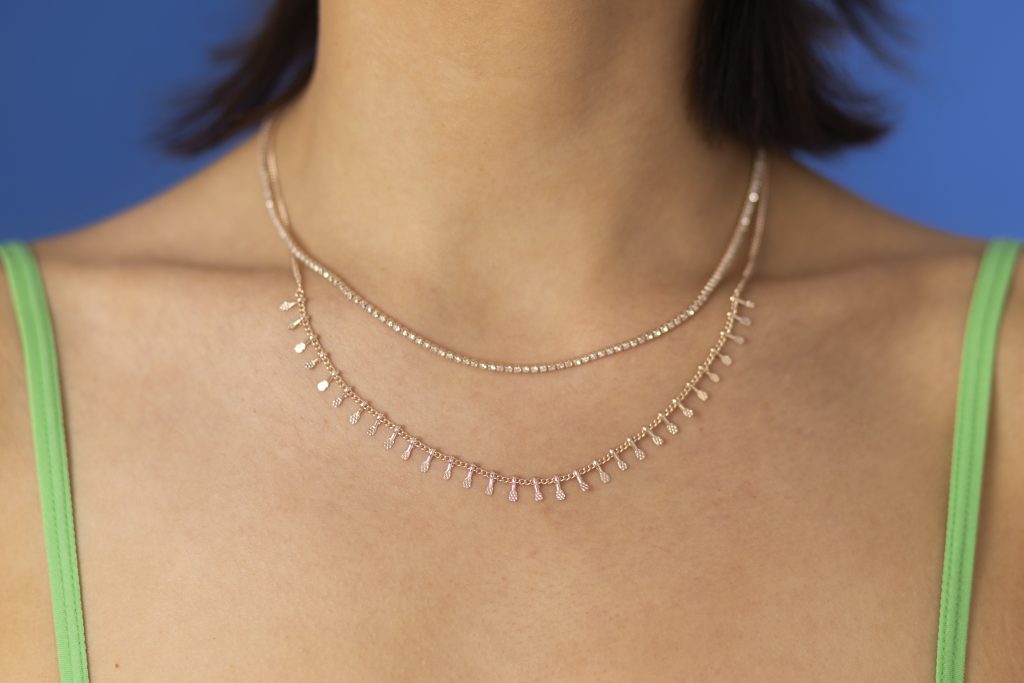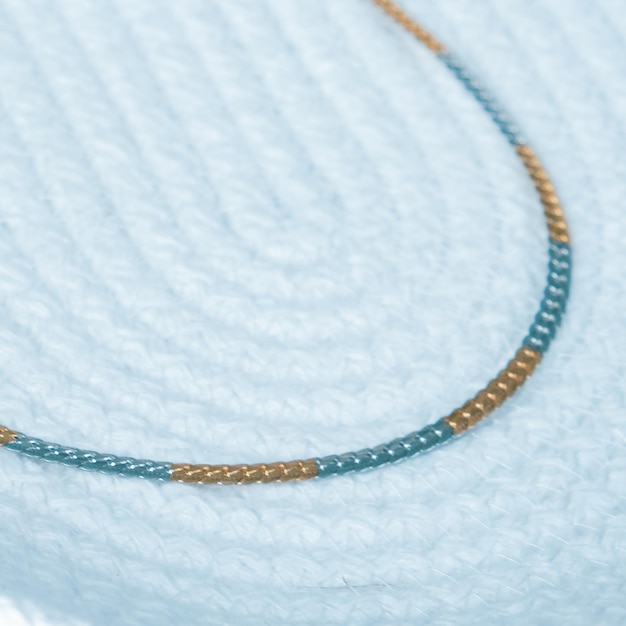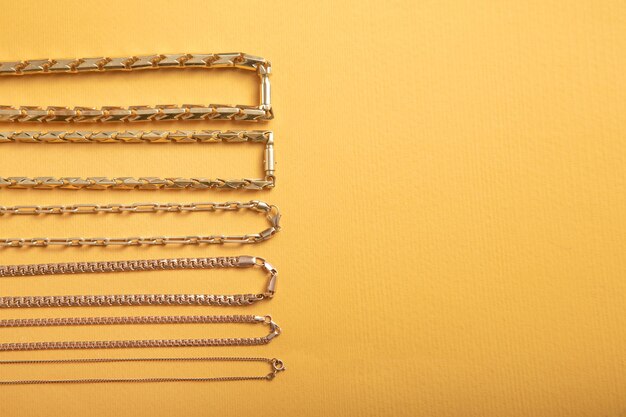Layering Necklaces: Your Ultimate Guide for Perfect Style

Ever wondered how some people effortlessly achieve that perfectly styled, multi-chain look? It’s all in the artistry.
The trend of Layering Necklaces has evolved from a simple accessory trick into a sophisticated form of self-expression, instantly elevating any attire.
This guide will empower you to move beyond simply hanging chains and start curating a signature look that’s uniquely yours.
Are you ready to transform your jewelry box into a tool for dynamic, personalized style? Let’s unlock the secrets to a flawless necklace stack.
The art of layering: a historical perspective and modern appeal
The allure of layered necklaces isn’t a new phenomenon; it echoes through centuries of adornment.
From ancient civilizations where multiple strands signified status and wealth, to the bohemian chic of the 1970s, the practice of wearing several necklaces at once has always been about more than just decoration.
It’s about personal narrative and curated style. Today, this trend offers an accessible way to personalize outfits and transition looks from day to night.
From ancient empires to modern runways
Historically, layered jewelry conveyed messages of power, protection, and identity. Egyptian pharaohs adorned themselves with intricate collars and multiple strands of beads made from precious stones and metals.
European royalty, too, embraced multiple necklaces, often embellished with pearls and gemstones, to showcase their affluence and sophistication.
The modern revival of layering, however, began in earnest in the early 21st century, gaining momentum as fashion became more about individual expression rather than rigid rules.
This shift has allowed for a playful exploration of different styles, encouraging wearers to experiment with pieces that might not traditionally be paired together.
Current fashion trends emphasize individuality and versatility, making layering necklaces a perfect fit.
It allows for a dynamic interplay between various elements – from delicate chains to bolder statements – creating a cohesive yet diverse look.
This adaptability ensures that layered necklaces remain a relevant and cherished part of contemporary fashion.
Ultimately, understanding the historical context enriches the appreciation of modern layering, highlighting its enduring appeal across different epochs and cultures.
The ability to mix and match allows for endless creativity, making each layered look uniquely yours. This blend of history and modernity ensures that layering necklaces will continue to be a beloved trend for years to come.
Understanding the foundations: necklace lengths and types
The cornerstone of any successful layered necklace look lies in a thorough understanding of different necklace lengths and types.
Just as an architect considers the foundation of a building, so too must the layering enthusiast consider the basic components of their jewelry ensemble.
Knowing the standard lengths and the common types of necklaces will provide the necessary framework for crafting harmonious and visually appealing arrangements.
This fundamental knowledge prevents tangles and allows each piece to shine.
Standard necklace lengths and their impact
Necklace lengths are typically measured in inches and determine where a necklace will fall on the body. Each length offers a distinct aesthetic and plays a specific role in layered combinations.
- Choker (14-16 inches): Sits snugly around the neck or at the base of the throat. Ideal as a starting point for layering, providing a close-to-the-skin base.
- Princess (17-19 inches): Rests just below the collarbone. Extremely versatile, suitable for almost any neckline, and pairs well with chokers or longer strands.
- Matinee (20-24 inches): Falls around or just below the center of the bust line. Perfect for adding length and creating a deeper V-shape, often used with pendants.
- Opera (28-36 inches): Extends to or just below the bust line. Can be worn as a single strand or doubled up for a layered effect, offering dramatic elegance.
- Rope (36+ inches): Any length longer than opera, often reaching the navel. Highly versatile, can be worn long, doubled, tripled, or even knotted for various styles.
Choosing the right combination of lengths is crucial. For instance, pairing a choker with a princess and a matinee length creates a classic tiered look.
The key is to ensure there is enough visual space between each necklace so that they don’t overlap awkwardly or tangle excessively.
Common necklace types and their versatility
Beyond length, the type of necklace also contributes significantly to a layered look. Different styles offer varying textures, weights, and aesthetics.
- Chain necklaces: These are the foundation of many layered looks. They come in various link styles (e.g., cable, figaro, curb, snake) and metal finishes, offering texture and a sleek base.
- Pendant necklaces: Feature a charm or decorative element hanging from a chain. Pendants add focal points and can introduce personal meaning or a pop of color/design.
- Beaded necklaces: Composed of various beads, offering texture, color, and sometimes a more bohemian or naturalistic vibe. They can be uniform or feature varied bead sizes.
- Lariat necklaces: Also known as Y-necklaces, these have no clasp and are often tied or threaded through a loop. They create a long, vertical line, ideal for deepening a layered look.
- Collar necklaces: Wider and stiffer than chokers, designed to sit high on the neck. They can add a bold statement and work as a strong top layer.
Mixing these types creates visual interest. A delicate chain with a bold pendant, combined with a string of subtle beads, can result in a sophisticated and rich design.
Experimenting with different types allows for the development of a unique personal style within the layering trend.
The golden rules of layering: balance, texture, and focal points
Mastering the art of layering necklaces extends beyond merely combining different lengths. It involves an intuitive grasp of balance, a keen eye for texture, and the strategic placement of focal points.
These “golden rules” transform a simple collection of necklaces into a cohesive and visually captivating statement.
Ignoring them can lead to a cluttered or uninspired arrangement, while embracing them ensures a polished and harmonious look every time.
Achieving visual balance in your stack
Balance is paramount to a successful layered look. It refers to the distribution of visual weight and ensures that no single piece overwhelms the others, or that the entire ensemble doesn’t appear lopsided.
- Varying lengths: As previously mentioned, using necklaces of distinct lengths is the most fundamental rule. Aim for at least 1-2 inch differences between strands for optimal spacing.
- Graduated aesthetics: Start with simpler, more delicate pieces closest to your neck, gradually introducing bolder or more intricate designs on longer chains. This creates a natural flow.
- Consider necklines: The shape of your clothing’s neckline heavily influences how your layered necklaces will sit. A V-neck beautifully frames longer, cascading layers, while a high crew neck might call for chokers and shorter chains. The goal is to complement, not compete with, your top.
A balanced stack ensures that each necklace gets its moment to shine without creating a “jumbled” appearance. Think of it as a symphony where each instrument plays its part, contributing to the overall harmony.
Embracing texture and material play
Texture adds depth and interest to your layered look, preventing it from appearing flat or one-dimensional. It’s about combining different tactile and visual surfaces.
- Mixing metals: Gone are the days when mixing gold and silver was a fashion faux pas. Incorporating yellow gold, white gold, rose gold, and even black rhodium-plated chains adds a modern, eclectic touch. The contrast in tones enhances visual appeal.
- Diverse chain link styles: Don’t limit yourself to one type of chain. Combine a sleek snake chain with a chunky paperclip link, or a delicate cable chain with a more intricate Figaro. Each link style offers a unique texture.
- Incorporating varied elements: Beyond metal, introduce elements like pearls, beads, leather, or even silk cords. A string of tiny pearls juxtaposed with a metallic chain creates a sophisticated contrast. Wood or stone beads can add an organic, earthy feel.
The interplay of textures makes a layered necklace stack feel rich and thoughtfully assembled. It shows an attention to detail that elevates the entire outfit.
Strategic placement of focal points
Every layered necklace combination benefits from one or more focal points – pieces that draw the eye and anchor the arrangement.
- Pendant power: A beautiful pendant on a longer chain often serves as the primary focal point. It can be a personal charm, a significant gemstone, or a unique design that reflects your personality.
- Statement pieces: Occasionally, a bolder, more substantial necklace can act as a centerpiece, with more delicate chains layered above or below it. This creates a strong anchor for the entire look.
- Asymmetry and negative space: Don’t be afraid to leave some negative space between layers, or to intentionally create a slight asymmetry. This can make the arrangement feel more organic and less rigid, allowing the focal points to breathe.
By consciously selecting and positioning your focal points, you guide the viewer’s eye and create a narrative within your jewelry, making your layered look truly impactful.
Choosing the right necklaces: from minimalist to maximalist
The journey to mastering layered necklaces involves understanding how to select the right pieces that align with your personal style and the desired aesthetic. Whether you lean towards a subtle, understated elegance or a bold, eye-catching statement, the principles of selection remain constant. This section explores how to curate your collection for both minimalist and maximalist layering, ensuring your choices contribute to a cohesive and stylish outcome.
The minimalist approach: subtle sophistication
Minimalist layering is about creating a refined look with fewer, often more delicate, pieces. The emphasis is on subtle elegance and quiet luxury.
- Delicate chains: Opt for thin, barely-there chains in precious metals like gold, silver, or rose gold. Think dainty cable chains, snake chains, or very fine curb chains.
- Small, meaningful pendants: Choose tiny pendants such as a single pearl, a small initial, a birthstone, or a minimalist geometric shape. These add personal touches without overwhelming the look.
- Fewer layers: Stick to two or three necklaces at most. This keeps the look clean and uncluttered. Varying the lengths by just an inch or two between each piece can be enough to create distinction.
- Consistent metals: While mixing metals is trendy, for a truly minimalist look, consider sticking to one metal tone. This creates a more uniform and serene aesthetic.

A minimalist stack is perfect for everyday wear, professional settings, or when you want your jewelry to complement rather than dominate your outfit. It speaks volumes through subtlety.
The maximalist statement: bold and expressive
Maximalist layering is about embracing volume, texture, and diversity to create an impactful and unique statement. It’s about confidence and self-expression.
- Variety in chain types and weights: Combine chunky chains (like Cuban links or large paperclip chains) with thinner, more intricate ones. Mix different link patterns for dynamic texture.
- Eclectic pendant mix: Don’t shy away from mixing larger, more intricate pendants with smaller ones. Incorporate charms, lockets, coins, or amulets with significant visual presence.
- More is more: Layer four, five, or even six necklaces. The key is to vary lengths significantly to prevent tangling and allow each piece to be seen.
- Mixing materials and eras: Incorporate elements beyond metal, such as raw stones, colorful beads, pearls of varying sizes, or vintage pieces alongside contemporary designs. This adds a rich narrative to your stack.
- Embrace color: Introduce necklaces with colorful gemstones or enamel details to add vibrant pops and create a more playful or dramatic effect.
Maximalist layering is ideal for making a fashion statement, enhancing a bohemian look, or for occasions where you want your jewelry to be a central part of your ensemble. It’s an opportunity to truly showcase your unique style and personality.
Styling your layered necklaces: practical tips for everyday wear
Once you’ve grasped the theoretical aspects of layering, the next step is to integrate these principles into your daily routine. Styling layered necklaces effectively for everyday wear requires practical considerations, from preventing tangles to matching them with various necklines and outfits. It’s about making this stylish trend work seamlessly and comfortably within your lifestyle.
Preventing tangles: a common challenge
One of the most common frustrations with layered necklaces is tangling. Fortunately, there are several practical solutions to minimize this issue.
- Vary lengths significantly: Ensure at least a 1-2 inch difference, or even more, between adjacent necklaces. This space allows each chain to fall independently.
- Use a layering clasp: These specialized clasps (often multi-strand) keep your layered necklaces separated at the back of your neck, preventing them from twisting into a single knot. They also make it easier to put on and take off multiple necklaces at once.
- Consider chain weight and texture: Lighter, more delicate chains tend to tangle more easily than heavier ones. Pairing a delicate chain with a slightly heavier one can sometimes help anchor the lighter piece. Smooth chains (like snake chains) may slide more and tangle less than textured ones.
- Store properly: Hang your layered necklaces or lay them flat in a jewelry box with dividers. Avoid tossing them into a pile, where they are almost guaranteed to tangle.
- Adjust throughout the day: A quick glance in a mirror and a gentle adjustment can prevent minor twists from becoming major knots.
By implementing these strategies, you can significantly reduce the annoyance of tangled necklaces, allowing you to enjoy your styled look without constant fuss.
Matching with necklines and outfits
The right neckline can enhance your layered necklace look, while the wrong one can make it feel cluttered or awkward.
- V-necks and scoop necks: These are ideal for layering as they provide an open canvas. They perfectly frame cascading layers, drawing the eye downwards and creating a flattering elongation. You can easily go from a minimalist three-chain look to a vibrant five-chain maximalist statement.
- Crew necks and high necklines: For higher necklines, short layers work best. Think chokers, princess lengths, and perhaps one matinee length necklace that falls just below the collarbone. A bold collar necklace can also make a statement over a high neck. Avoid overly long or chunky pieces that might get lost in the fabric.
- Off-the-shoulder and boat necks: These necklines draw attention to the collarbone and shoulders. Delicate, shorter layers that graze the collarbone are often most flattering, complementing the décolletage without competing with it.
- Strapless tops: Similar to V-necks, strapless tops offer a beautiful open space for layers. Consider starting with a choker and building down with various lengths.

Beyond necklines, consider the overall outfit. Casual outfits pair well with a mix of metals and textures, while more formal attire might call for refined, uniform metal layers. The goal is always to create a cohesive look where the jewelry elevates the clothing, and vice versa.
Beyond the basics: advanced layering techniques and creative combos
Once comfortable with the foundational aspects of layering necklaces, it’s time to explore more advanced techniques and unleash your creativity. Moving beyond simple graduated lengths opens up a world of possibilities, allowing for truly unique and personalized expressions. These advanced tips focus on intentional asymmetry, incorporating bold elements, and understanding the art of thematic layering.
Playing with asymmetry and negative space
Traditional layering often emphasizes perfect symmetry and even spacing, but embracing asymmetry can add an edgy, modern twist to your look.
- Off-center pendants: Instead of having all pendants perfectly centered, try slightly shifting one or two to the side. This creates a dynamic, unexpected focal point.
- Varying chain styles strategically: Pair a delicate chain on one side with a chunkier chain on the other. This visual imbalance, when done intentionally, can be incredibly stylish and add visual intrigue.
- Incorporating lariats or Y-necklaces: These styles naturally create a vertical line that can disrupt the horizontal flow of other necklaces, adding an element of surprise and fluidity. They help to break up the “stacked” look and provide a cascading effect.
- Using negative space as design: Instead of filling every available space, allow intentional gaps between certain necklaces. This gives each piece room to breathe and allows the eye to appreciate the individual elements within the stack.
Asymmetry often makes a look feel more organic and less “put together,” giving it a natural, effortless vibe. It’s about controlled chaos that results in beauty.
Incorporating statement pieces and bold elements
While delicate chains are often the backbone of layering, integrating one or more bold pieces can transform your entire stack from subtle to show-stopping.
- Chunky chains as a base: Start your stack with a thick, substantial chain closer to the neck. Then, layer more delicate pieces underneath or mixed in, using the chunky chain as a powerful anchor.
- Oversized pendants: Introduce one significantly larger pendant on a longer chain, allowing it to become the undeniable focal point. Surround it with thinner, supporting layers.
- Gemstone presence: Don’t shy away from necklaces featuring large, uncut gemstones or clusters of smaller, vibrant stones. These add weight, color, and undeniable visual interest.
- Mixing eras and styles: Combine a contemporary minimalist chain with a vintage locket, or an antique cameo with a modern paperclip link. This creates a rich narrative and showcases unique personal style.
The key to incorporating bold elements without overwhelming the look is strategic placement and ensuring there’s still a visual hierarchy. One or two statement pieces are usually enough to elevate the entire ensemble.
Thematic layering and storytelling through jewelry
The most advanced form of layering involves creating a cohesive theme or telling a story through your chosen necklaces. This goes beyond mere aesthetics and delves into personal meaning.
- Color palette: Select necklaces that share a common color palette – perhaps all blues and greens, or warm earthy tones. This creates a visually harmonious and intentional look.
- Material consistency: For a more curated look, stick to specific materials like all pearls, all beaded, or a combination of various wooden elements.
- Meaningful charms: Gather pendants that represent significant life events, loved ones, or personal beliefs. For example, a birthstone, a zodiac sign, a lucky charm, and an initial combine to tell your personal story.
- Travel inspiration: Collect necklaces from different places you’ve visited and layer them to evoke memories of your adventures.
- Spiritual or symbolic: Layer pieces with various spiritual symbols or cultural significance that resonate with you, creating a meaningful and beautiful narrative.
Thematic layering transforms your necklaces from mere accessories into powerful symbols of your journey, values, and passions. It’s the ultimate expression of personal style.
Caring for your layered necklaces: maintenance and longevity
After investing time and effort into curating and styling your layered necklaces, it’s essential to understand how to properly care for them. Proper maintenance not only preserves their shine and beauty but also significantly extends their lifespan. Neglecting care can lead to tarnishing, breakage, and dullness, diminishing the impact of your carefully crafted layered look. This section provides practical advice on cleaning, storage, and general handling to ensure your necklaces remain pristine.
Regular cleaning for enduring sparkle
Even the most precious metals can tarnish or accumulate grime from skin oils, lotions, and environmental factors. Regular, gentle cleaning is crucial.
- Soft cloth wipe-down: After each wear, gently wipe your necklaces with a soft, lint-free cloth (like a jewelry polishing cloth). This removes oils and dirt before they can build up.
- Mild soap and water: For a deeper clean, mix a few drops of mild dish soap with warm water. Soak your necklaces for a few minutes (avoid this for pearls, opals, or soft stones), then gently scrub with a soft brush (like a baby toothbrush). Rinse thoroughly under cool, running water and dry completely with a soft cloth. Ensure no moisture remains to prevent water spots or tarnishing.
- Professional cleaning: For heavily tarnished pieces, intricate designs, or delicate gemstones, consider professional cleaning by a reputable jeweler. They have specialized tools and solutions to restore your jewelry safely.
- Avoid harsh chemicals: Steer clear of abrasive cleaners, bleach, ammonia, or alcohol-based products, as these can damage metals, stones, or finishes.
Consistent cleaning rituals will keep your necklaces looking brilliant, ready for your next layering adventure.
Optimal storage to prevent damage and tangling
How you store your necklaces directly impacts their condition and ability to prevent tangles discussed earlier.
- Individual compartments or hanging: The best way to store necklaces, especially layered sets, is to hang them individually on a necklace tree or
a stand. Alternatively, store them in a jewelry box with separate compartments or velvet-lined slots to prevent them from rubbing against each other or tangling. - Anti-tarnish strips: For silver or other prone-to-tarnish metals, place anti-tarnish strips in your jewelry box or bags. These strips absorb airborne pollutants that cause tarnishing.
- Airtight bags: For occasional wear pieces, storing them in small, airtight plastic bags (like Ziploc bags) can significantly slow down the tarnishing process by limiting exposure to air and humidity.
- Avoid extreme conditions: Do not store jewelry in direct sunlight, extreme heat, or high humidity, as these conditions can accelerate tarnishing or damage certain materials. The bathroom, for example, is not an ideal storage location due to humidity fluctuations.
Proper storage is a simple yet effective way to protect your investment and maintain the integrity of your layered necklaces for years to come.
General handling and longevity tips
Beyond cleaning and storage, conscious handling contributes to the longevity of your necklaces.
- Put on jewelry last: Always apply lotions, perfumes, hairspray, and cosmetics before putting on your necklaces. The chemicals in these products can dull or damage metals and stones.
- Remove before activities: Take off your necklaces before showering, swimming (especially in chlorinated water or saltwater), exercising, or doing household chores. This prevents exposure to harsh chemicals, snags, and physical damage.
- Check clasps and links: Periodically inspect your necklace clasps to ensure they are secure and check links for any signs of weakening or stretching. Addressing minor issues promptly can prevent loss or breakage.
- Be gentle: Avoid pulling or tugging on your necklaces. While they are designed to be durable, excessive force can break delicate chains or dislodge stones.
By integrating these care practices into your routine, you ensure that your layered necklaces remain beautiful, functional, and ready to enhance your personal style for many years.
| Key Point | Brief Description |
|---|---|
| 📏 Vary Lengths | Crucial for preventing tangles and creating visual tiers. |
| 💎 Mix Textures | Combine different chain types, metals, and materials for depth. |
| ✨ Focal Points | Use a prominent pendant or chain to anchor your layered look. |
| 🧼 Proper Care | Clean and store necklaces correctly to maintain their beauty and prevent damage. |
Frequently asked questions about layering necklaces
There’s no strict rule, but most stylists recommend layering 2 to 5 necklaces. Starting with 3 is a great way to achieve a balanced look without overwhelming your outfit. For a minimalist aesthetic, 2 or 3 are ideal, while a maximalist approach might involve 4 or more, depending on their individual designs and weights.
Absolutely! Mixing metals like gold, silver, and rose gold is not only acceptable but encouraged in modern fashion. It adds depth, visual interest, and a contemporary edge to your layered look. The key is to do it intentionally, ensuring the different metals complement each other rather than clash.
To prevent tangles, always use necklaces of significantly varied lengths, ideally with at least a 1-2 inch difference between each. Consider investing in a multi-strand layering clasp, which holds your necklaces separated at the back of your neck. Proper storage, like hanging them or using individual compartments, also helps immensely.
Not necessarily. A well-layered look often includes a mix of plain chains and chains with pendants. Start with a delicate chain, add a pendant on a slightly longer chain to create a focal point, and then perhaps finish with another plain chain or a different textured chain. This combination creates balance and visual appeal.
A good starting point is to select a choker (14-16 inches) or a princess length (17-19 inches) as your shortest layer. Then, add necklaces that are progressively longer, such as matinee (20-24 inches) or opera (28-36 inches) lengths, ensuring each piece has enough space to hang distinctly without overlapping excessively.
Conclusion
The way Wall Street reacts to EU tariffs serves as a vital lesson in the interconnectedness of global finance and trade policy.
These trade defense mechanisms are no longer niche concerns; they are fundamental drivers of market sentiment, corporate strategy, and economic growth forecasts.
For the investor, the path forward requires agility, meticulous research, and a long-term perspective.
The key to navigating this complexity lies in staying ahead of policy changes, analyzing corporate resilience, and adjusting investment portfolios to minimize risk while capitalizing on the opportunities created by this new economic paradigm.
Ultimately, the successful investor is the one who transforms trade uncertainty into a strategic advantage.
For further detailed analysis on how global markets are responding to these developments, including an in-depth look at European markets’ performance in comparison, you can find valuable insights here: https://finance.yahoo.com/news/europe-green-wall-street-hesitates-111633582.html.
Would you like me to elaborate on a specific sector’s vulnerability to these new tariffs, such as the impact on the technology industry?
Liked the article?





